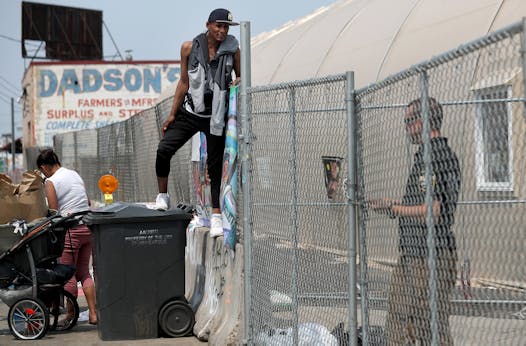People loaded their belongings into grocery carts, bags and suitcases on move-out day at the temporary shelter for homeless encampment residents in Minneapolis on Monday. But advocates and city officials made it clear: The Twin Cities' homeless crisis is far from over.
The Navigation Center opened last fall to house the residents from the hundreds of tents that sprang up along Franklin and Hiawatha avenues. The center's population reached 176 people this winter, but had dwindled to 25 by Monday. They were offered shelter beds.
"We hope that they all elect to take us up on those offers elsewhere in our shelter system," Steve Horsfield, executive director of Simpson Housing Services, said during a news conference Monday afternoon.
In the days and hours before the planned closure, people were gathered outside the gate off Cedar Avenue S. The fence along the sidewalk was strewn with trash and people were sitting on the pavement or under the trees. Some could be seen using needles.
While the city, county, tribal officials and other advocates declared the Navigation Center a success, they acknowledged Monday the challenges that came with providing shelter and finding homes for everyone.
"It is a beautiful day to see a completion of what was a very crisis-driven time back in the fall," said Patina Park, who spoke on behalf of the Metropolitan Urban Indian Directors. "We're not going to solve a problem that is literally hundreds of years in its design, but we are making excellent steps now to come up with true solutions with everyone at the table."
Minneapolis city officials approved $1.5 million initially to coordinate with nonprofit organizations and Red Lake Nation to move people to three heated tents on a property owned by the tribe. The city had spent $3.2 million as of April.
City officials revealed at a public meeting in April that half the people who left the center had found permanent housing, but the rest ended up in jail, back on the streets or their whereabouts aren't known. Two people at the center died from overdoses.
Red Lake Nation now plans to build a permanent housing complex on the site.
Minneapolis Mayor Jacob Frey said during the news conference that he was "proud of the work we've done" with the center but acknowledged there was room for improvement. Asked about the possibility of other encampments coming this summer, he said they were "not safe."
"It's everything from drug trafficking to human trafficking to issues with safety and fire, and that is not a successful nor a safe mechanism to deal with those who are experiencing homelessness going forward," Frey said.
Some residents of the Navigation Center said they had previously been offered housing but turned it down because they didn't want to live in a communal environment. One of them is Kat Yanez, a leader at the tent camp, dubbed the Wall of Forgotten Natives. Yanez said in an interview that she is considering starting a new tent encampment.
She said many of the last residents at the center still need access to substance abuse services. Her sister died from an overdose. Yanez said she herself suffers from depression and a heroin addiction that she wants to kick but "I don't want anyone left behind."
"We're still out here fighting for what we need," Yanez said.
A point of contention throughout the center's existence was that people were allowed to use drugs, a major divergence from typical shelters. Some former residents say that was a selling point. Residents were expected to work with staff to find safer drug use strategies or get into treatment, Horsfield said.
Jessie Saavedra, a health educator for Ramsey County's Clinic 555, was handing out syringes to people still at the center in the afternoon. He has stopped by every Monday since the center opened to pick up dirty needles, hand out clean syringes and test people for HIV and hepatitis C.
Saavedra pointed out that the center provided education and other harm reduction efforts to keep people safe while they used. Some of the people from the center were getting treatment while others who were displaced had gone to "wet houses" in St. Paul where they can still use drugs.
"If you have an opportunity to go in a safe, closed environment and shoot up rather than going to a phone booth, a bathroom that the public uses or an alleyway, which would you prefer people to use?" Saavedra said.
City officials said in a news release Monday that 84 people from the Navigation Center were connected to housing, nursing homes or treatment programs through partnerships with Simpson Housing and Red Lake Nation.
People who used to live there sometimes found it hard to stay away.
Ricky Robinson-Myers stayed in both the tent encampment and the Navigation Center after escaping an abusive relationship. Case managers found him an apartment last week and he now has a one-year lease. But Robinson-Myers has gotten used to the "ding, ding, ding" of the light-rail trains and hearing people talk at all hours of the night. He's scared to be alone.
That's why on Friday and Monday, he was outside the center's gates, waiting to get donated furniture for his apartment and talking to friends he made.
"Once you get stuck with having people help you, you stay in that routine," Robinson-Myers said.
Staff writer Emma Nelson contributed to this report.
Charge: Driver going 77 mph ran red light, fatally hit man crossing St. Paul street and kept going

Second teen suspect arrested in Minneapolis 'Nudieland' mass shooting that killed 1, injured 6
Charges: Friendly fire killed man standing among group who shot at moving SUV in south Minneapolis

Lakeville public safety training facility gets $800K in federal funding



